The 23-year-old musical genius and frontman for The Bobby Fuller Four was on the brink of superstardom when he was found inexplicably burned and bruised in the front seat of his mom's car.
In the early afternoon of July 18, 1966, Lorraine Fuller returned to the parking lot of her apartment building in Los Angeles. Ever since that morning, both her car and her son Bobby Fuller had been missing. She kept checking the lot as she became more anxious by the minute. But there was no sign of her vehicle — or her beloved son inside it.
The mother of two boys, Lorraine Fuller constantly worried about her family. Her eldest son Jack had been murdered in a robbery back in 1961 and her fear for her remaining sons kept her up at night.
Perhaps that was why she’d followed her 20-something children to Los Angeles in the first place even though both boys were members of a famous band, the eponymous Bobby Fuller Four.
All morning the missing blue Oldsmobile provided Lorraine Fuller with dual strains of dread and hope. Bobby Fuller hadn’t come home last night. But as long as the car was gone, it was possible both the vehicle and her son could return at any moment.
But Bobby Fuller had missed a major meeting earlier that day between the band members and their label, Del-Fi. Originally scheduled for 9:30 a.m., the meeting had been rescheduled multiple times that day with no sign of the singer. Anyone who knew Bobby Fuller knew that he took his career seriously. It wasn’t like him to miss appointments, especially ones related to his music.
Although she had checked the parking lot 30 minutes beforehand that same afternoon, Lorraine Fuller couldn’t help herself but check again. This time around, she did see her car. Her 23-year-old son was propped up in the front seat. He wreaked of gasoline and blood.
Was Bobby Fuller’s Death Really An Accident?
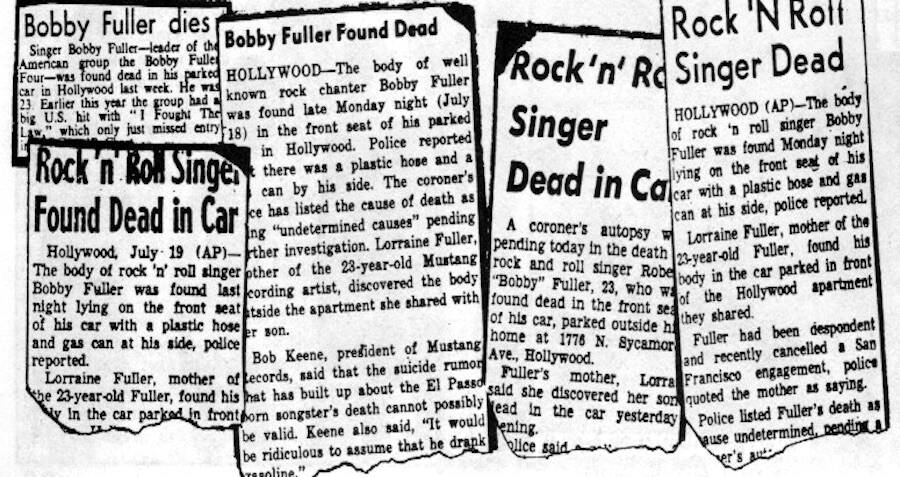
Internet ArchiveSelection of newspaper headlines on Bobby Fuller’s death from Kicks magazine.
According to The Encyclopedia of Dead Rock Stars, the bruised, burned, and bloodied body of the fallen star was taken to a local hospital after he was found.
Soon thereafter, the cause of Bobby Fuller’s death was listed as asphyxia due to the inhalation of gasoline. Multiple newspapers heavily implied that he died by suicide and police seemed satisfied enough with that explanation too — despite his family’s protests.
But even the coroner couldn’t be sure what or who really killed Bobby Fuller, and left two question marks beside the boxes for “suicide” and “accident.”
Fuller was laid to rest in Forest Lawn Memorial Park in Hollywood Hills. He is marked simply as a “beloved son.”
In the years since Bobby Fuller’s inexplicable death, changing times and tastes have reduced the “Rock ‘n’ Roll King of the Southwest” and “I Fought the Law” writer to something of a footnote. But back in early 1966, even Beatles’ George Harrison described The Bobby Fuller Four as his most listened-to group.
These days, Fuller may be best remembered for his odd death.
Indeed, more than 50 years later, the question remains — did he really take his own life at the height of his fame? Or, as his family has always maintained, was something much fouler at play?
Humble Beginnings In Texas
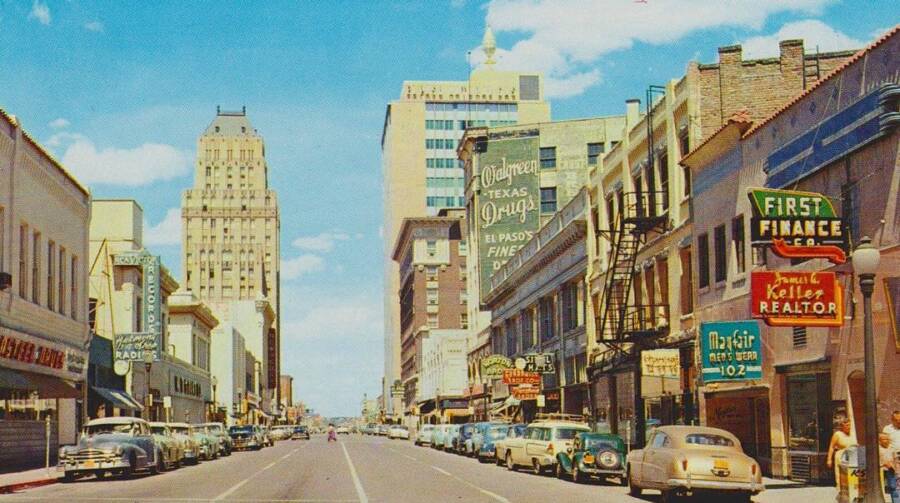
Wikimedia CommonsEl Paso, Texas c. 1940-1950.
Robert “Bobby” Gaston Fuller was born October 22, 1942, in Baytown, Texas, just outside of Houston. His father, Lawson, worked in the oil industry and his career moved the family around the western United States quite a bit. Fuller and his younger brother Randy grew up around Salt Lake City before moving with the rest of their family to El Paso, Texas.
It was a move none of them wanted. The boys were worried about leaving behind their friends and changing schools. Their mother worried about El Paso’s troubled reputation. Sure enough, what the Fuller brothers found upon their arrival was a hotbed of hormonal teenage rebellion brewing beneath the surface of 1950s America.
Located just 11 miles from the Mexican border city of Juarez, El Paso represented both a cultural melting pot and a good place to get into mischief.
Although El Paso was technically located in a dry county, Juarez served as its soaked sibling, setting itself up as a drinker’s destination since the prohibition era. Among the cheap bars, a new sound was spawning, featuring fast guitar sets to traditional Mexican tempos mixing streams of blues and rock ‘n’ roll.
For Fuller, this was an environment rich in more than just temptation and trouble. It was a testing ground and school for discovering the “West Texas sound” he felt was central to that era’s rock music.
“This Guy Is Not Normal.”

Michael Ochs Archives/Getty ImagesThe Bobby Fuller Four skyrocketed to success when their single “I Fought the Law” made it to the top 10 in the spring of 1966.
Fuller, already a drummer, began to teach himself guitar and several other instruments as well. As a friend later remembered, on one occasion Fuller played a drum solo and then piano for 10 minutes. Then, he casually mentioned he had learned how to play the saxophone in the last five months.
“Yeah right,” his friend responded, “How the hell can you learn to play a saxophone in five months?”
Then, by his recollection, “[Bobby] picked up the sax and did everything you possibly could do on a saxophone in two or three minutes… at this point it was like, ‘Oh Jesus! This guy is not normal. He’s not normal!'”
Before long, Fuller was no longer satisfied staying in the audience on either side of the border. In Juarez, he began playing semi-regularly with the rock ‘n’ roll guitarist Long John Hunter. In El Paso, he became the drummer for a local band called The Embers, winning contests and local notoriety.
Switching from drums to guitar, Fuller began piecing together a group of his own by pulling from the most talented teenagers he could find. Including his brother, Randy, Bobby Fuller had three out of four members of what would become The Bobby Fuller Four playing together by 1959. Only Bobby Fuller and his brother were consistent members of the quartet as the other two positions changed multiple times throughout the band’s existence.
But in February of that same year, a tragic event would change Bobby Fuller’s outlook on music forever.
Chasing A Dream Of Rock Stardom
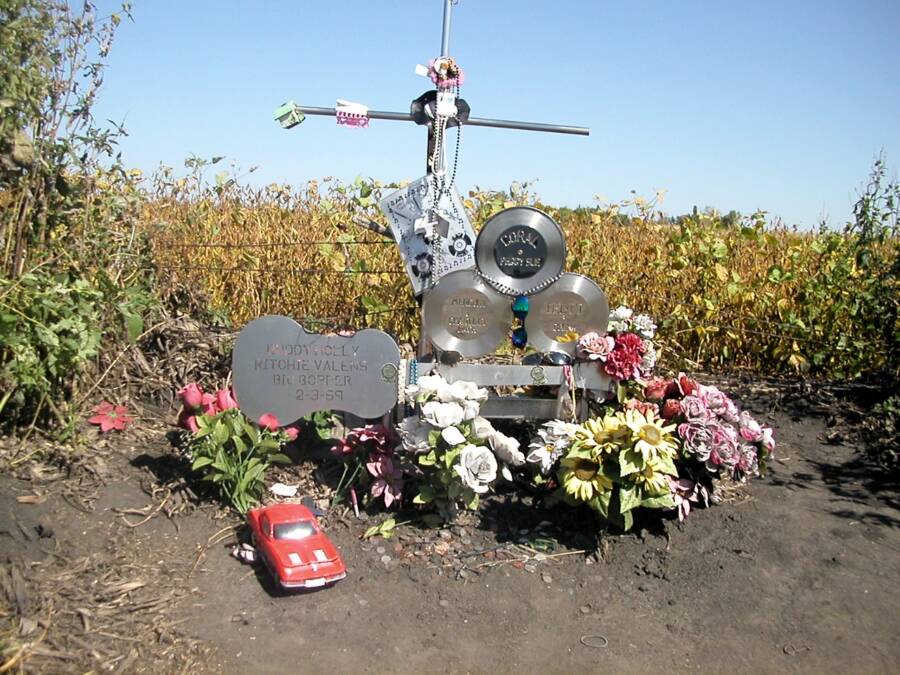
Wikimedia CommonsMonument for “The Day the Music Died” victims at the site of the 1959 plane crash.
On February 3, 1959, Buddy Holly, Ritchie Valens, and JP Richardson “The Big Bopper” all died in a plane crash in Iowa. All of them were under 30 years old and at the height of their fame. The tragedy would later be known as “The Day The Music Died.”
Holly, who was just 22, had been an enormous influence on Fuller. Inspired by the same Texas musical style, Bobby Fuller saw himself in Holly during the songwriter’s rise to fame and even more so after his death. In addition to learning every Buddy Holly song he could, Fuller modeled his appearance and playing style off his idol’s image before learning to develop and trust in his own identity.
For instance, one of the attributes that set Bobby Fuller apart from other musicians was his fascination with audio technical equipment. After acquiring a tape recorder to take to the clubs in Juarez, Fuller began experimenting with a guitar in his bedroom. He soon discovered the effects he could create by playing into the machine directly.
Although not trained in classical composition, Fuller had an all-consuming drive to capture the sounds inside his head. In an attempt to figure out echo effects, Fuller and his brother Randy poured a cement slab against one wall of the house and covered the outside with whatever materials they could find to cancel out sound.
While the conditions of its creation are a bit dubious, the “demo” Fuller produced from these efforts had the desired effect. He even caught the attention of Buddy Holly’s original producer, Norman Petty, who agreed to record with him at his studio in Clovis, New Mexico. Ironically, Fuller ended up hating the results.
Experiments In Self-Expression
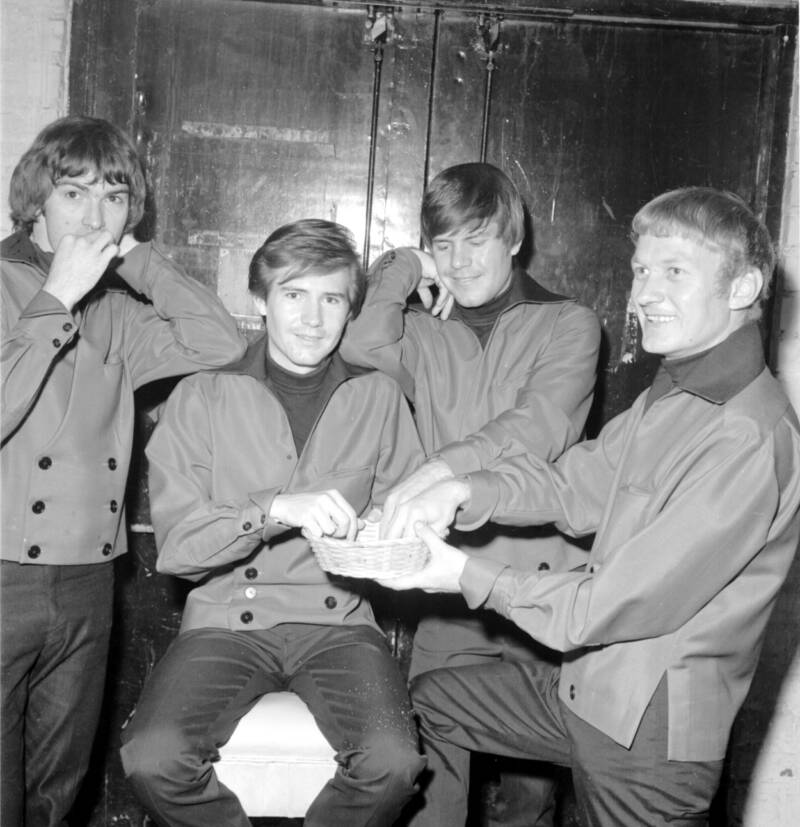
Michael Ochs Archives/Getty ImagesThe Bobby Fuller Four only had two consistent members: Bobby and his brother Randy Fuller.
As another artist who worked with Petty around this time recalled: “Petty’s process was counter to the very essence of rock ‘n’ roll, which is at minimum a spontaneous emotional explosion of teenage feelings and thoughts and one not planned and carefully hammered out by adult engineering seeking form and coherence.”
Unwilling to be molded even by the mentor of Buddy Holly, Fuller returned to El Paso determined to do things his own way. Sometimes this required the financial support of his parents, who helped him to buy expensive microphones. But most of all, Fuller relied upon the patience of everyone around him as he turned his family’s home on the aptly named Album Avenue into a recording studio.
In 1988 Lorraine Fuller put it lightly when she said, “We had wires all over the house.” In fact, she and her husband let the boys carve a hole in the living room wall to create a double-paned glass window to aid in their recording sessions. Once, she recalled, neighbors called the police about the noise at the Fuller house. The officers ended up staying to hear Fuller play and left without incident.
In addition to recording, pressing, and selling his own albums, Fuller had made himself a hub in the El Paso music scene by opening up the house to other bands. In addition to an act of goodwill, this practice allowed Fuller to listen to and record all his local competition in order to study and improve upon what they were doing.
Fuller’s First Taste Of Surf Rock
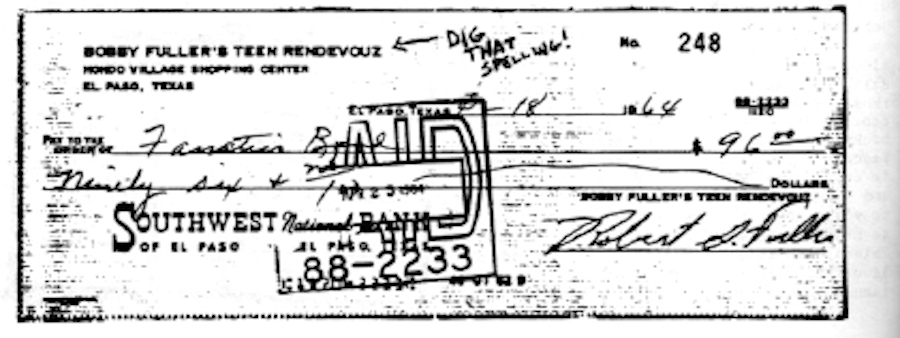
Internet ArchiveA check from Bobby Fuller’s Teen Rendezvous Club with annotations from Kicks magazine.
Finally feeling up to the task, the Fuller brothers went to California in pursuit of a recording contract. In this regard, the visit was a total failure, with the sole positive feedback coming from Del-Fi records’ Bob Keane who told them to come back in a year. But it was a cultural awakening for both of them, especially Fuller, who readily absorbed the music of the Beach Boys and other surf rock bands as well as the trappings of California teen culture.
Returning to El Paso, Fuller resolved to bring a bit of California with him. With his father as a co-signer on a lease, Bobby rented out a local nightclub that had lost its liquor license to create “Bobby Fuller’s Teen Rendezvous,” a play-off of the popular 21-and-under clubs which were then all over Los Angeles.
Remembered mostly as a fire hazard by Randy Fuller (the club’s central decor was made up entirely of old military parachutes), the Teen Rendezvous served two purposes. For one, it gave the youth of El Paso a place to party and, more importantly, it was a chance for Bobby Fuller to show off local talent — including his own.
“What’s This Guy Still Doing Here?”
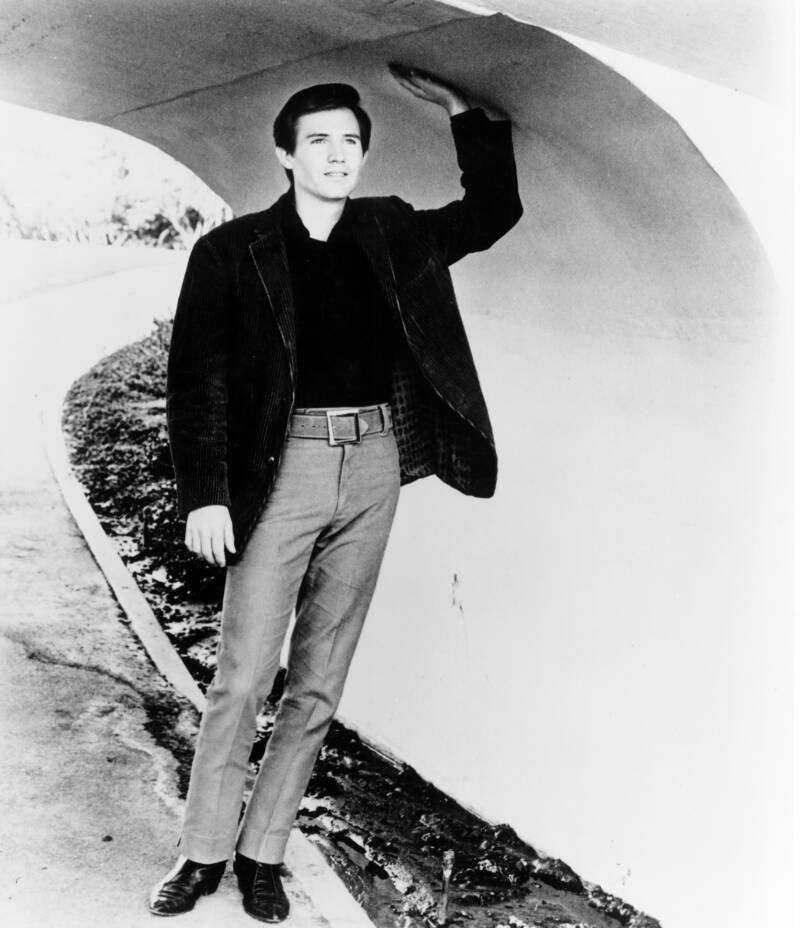
Michael Ochs Archives/Getty ImagesBobby Fuller was an instant sex symbol, however, he was on the Dating Game twice and didn’t win either time.
There was a growing sense in the El Paso music scene that Fuller was a big fish in a small pond. As the El Paso Herald-Post put it in a 1964 headline, “England Has Beatles, But El Paso Has Bobby.”
Mike Cicarrelli, a friend of Fuller’s, later said, “Everyone in town is like, ‘Is he gonna make it?’ It’s not a matter of if, it’s when. He’s gotta get the hell outta here. It was like, man, what’s this guy still doing here? It was a destiny factor in this town, it was like man, this guy’s unbelievable. You had to go to the West Coast.”
Bobby Fuller seemed happy to stay in El Paso and keep the club running. However, after a few too many fights broke out, Bobby Fuller’s Teen Rendezvous was shut down. At around the same time, Randy had been in a fight and pulled a gun on another club patron. The final straw was a letter from the El Paso Federation of Musicians which cut ties with Fuller for breaking various union rules.
Still, as Randy Fuller later recalled, Bobby needed to be convinced to go to California. He said, “I’m not really sure if Bobby would’ve come out if I hadn’t really pushed it.” Perhaps his first attempt to make it big had scared him. Or maybe he had a premonition of where this path might lead. Whatever the reason, when the Bobby Fuller Four finally moved to California, the entire Fuller family came too.
Bob Keane at Del-Fi was true to his word. After hearing the band play again, he agreed to sign them for a record deal. Although in some stories this might be the happy ending, here it marks the beginning of an unfortunate end.
Commercial Success And Creative Strain
Del-Fi did not have much money from the start. The band’s first LP “Let Her Dance” actually needed to be recorded by a different studio because Del-Fi’s own equipment was not up to standards.
Despite the radio success of the title single, Del-Fi’s nationwide distribution was outsourced to another firm that failed to release the full album for nearly four months which totally deflated its momentum.
Bobby Fuller chafed at the studio’s suggestions for how they should look and sound, but the biggest problem for most members was the name the label had chosen, “Bobby Fuller and the Fanatics.”
After seeing the first printing of “Let Her Dance” under this name, Randy picked up a record and threw it at the executive’s head. He said, “This is bullshit, we’re a band, not the guys in his band.” After that, they compromised on a new name, “The Bobby Fuller Four.”
At around this time, the band began recording its second LP “I Fought the Law,” featuring their cover of the titular tune originally written by The Crickets.
Although the track had always done well when they played it live, it was Randy’s idea to record it for the album, as he felt the song spoke to his own troubled history with the police. It seemed Bobby enjoyed recording the song as well. In the original 2:19 version, he slipped in “good fuck” instead of “good fun” during one verse, a subtle joke that slipped by the censors.
In some ways, this jab might provide a window into Fuller’s mental state at the time. On one hand, Del-Fi had set up The Bobby Fuller Four as the house band at the beachside concert venue Rendezvous Ballroom while the album was being finished. A nationwide tour was planned. But at the same time, Fuller was fighting with studio executives who wanted him to take pointers from Barry White and create “overdone” tracks full of effects that could not be recreated live.
Bad Luck Or Ominous Warnings?
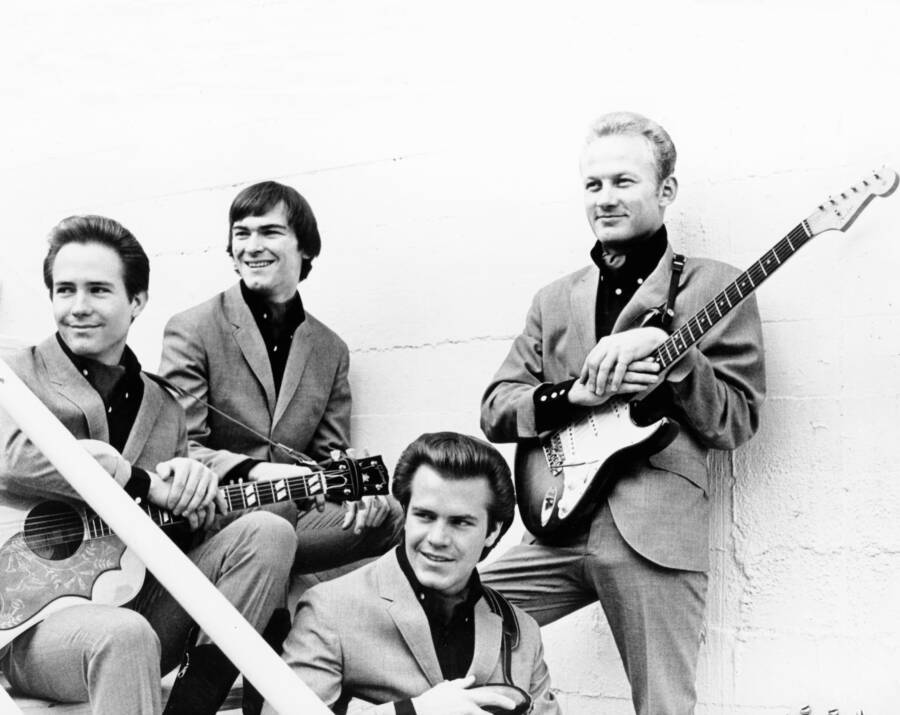
Michael Ochs Archives/Getty Images“England has the Beatles but El Paso has Bobby,” the El Paso Herald Post published in September 1964.
When The Bobby Fuller Four’s first and only nationwide tour kicked off in the winter and spring of 1966, the end really began. Overcharged by bars, improperly booked at hotels, and playing to audiences who did not know their music nor care for it took a toll on the members. They started fighting and their fraying nerves displayed themselves in other ways.
After one show at an East Coast country club, Randy took revenge against the snooty attendees by blowing up the building’s porch with an M80 as they left. After fleeing from police, the group was eventually picked up for speeding and had to steal their van and equipment from the local impound lot.
At one of their last concerts, other band members started to notice something was “off” about Fuller. He seemed out of it and uncoordinated. Jim Reese, The Bobby Fuller Four’s other guitarist, suspected that he might have been experimenting with LSD at the time.
On the morning of July 18, 1966, all the members of The Bobby Fuller Four were expected for tense negotiations with their label about the band’s direction and a future European tour. At first, when Fuller did not show up, the others thought he was being a diva. But, when his body was found later that afternoon, it was clear he might have already been dead for some time.
According to Fuller’s friend Rick, Bobby Fuller had consumed a few beers before midnight on July 17. Although Rick says he fell asleep shortly after midnight, he noticed Fuller had left when he woke up at about 2:30 a.m. The last person who admitted to seeing Fuller alive was his landlord, Lloyd, who reported that Fuller had stopped by his apartment at about 3 a.m. to drink more beer.
All speculation as to what happened to Bobby Fuller in the hours he was missing must, officially, remain just that. But let us examine the two sides of the story of his death.
Theory 1: Bobby Fuller’s Death Was Suicide
Bobby Fuller’s death was assumed to be a suicide almost immediately. Some think he may have killed himself because his mother Lorraine mentioned he had been “despondent” when asked about her son’s mood before he died. Indeed, the issues with his label aside, Fuller had other things on his mind. He had thought about going solo. He was considering going back to El Paso and starting a new club and his love life was in shambles.
“Everyone in town is like, ‘Is he gonna make it?’ It’s not a matter of if, it’s when.” — Mike Cicarrelli, a friend of Fuller’s.
His former fiancée, Pamela, had recently broken up with him in a letter and at around the same time, he had also run into an old flame backstage at a concert.
Suzie “Doe” had first met Bobby Fuller at his club in El Paso back in 1964. Their relationship became romantic almost immediately, but Fuller was still technically engaged to Pamela. When Suzie revealed she was pregnant, Fuller offered to drive her to Juarez where they could discreetly seek an abortion. Suzie said she would only do so if Fuller agreed to marry and divorce her in Mexico so that at least she could say they had been married. Worried about what his fans would think, Fuller refused.
Instead, they came up with a compromise. To spare both of their parents the shame of a child born out of wedlock, Fuller arranged for Suzie to marry Bruce, a salesman who was friendly with the brothers, and pass off the pregnancy as legitimate. Suzie agreed, though she said that she cried the whole night before her wedding, through the service, and all through the wedding night.
Two years later, she approached Bobby after a show and introduced him to his daughter. Fuller was clearly uncomfortable with the exchange and the meeting did not last long. Still, Suzie felt moved to send Fuller a long letter, pleading with him that she still loved him and wanted them to be a family.
Given the context, when news broke about Bobby Fuller’s death not long afterward, “I thought it was my fault,” Suzie said. “I thought after he got my letter was that it was my fault because the first reports said that he’d killed himself. I thought that my letter — and what I had said at the end, like in a wedding ceremony where it says, ‘and no man shall put asunder.’ That was my last line in my letter. I thought he committed suicide from my letter.”
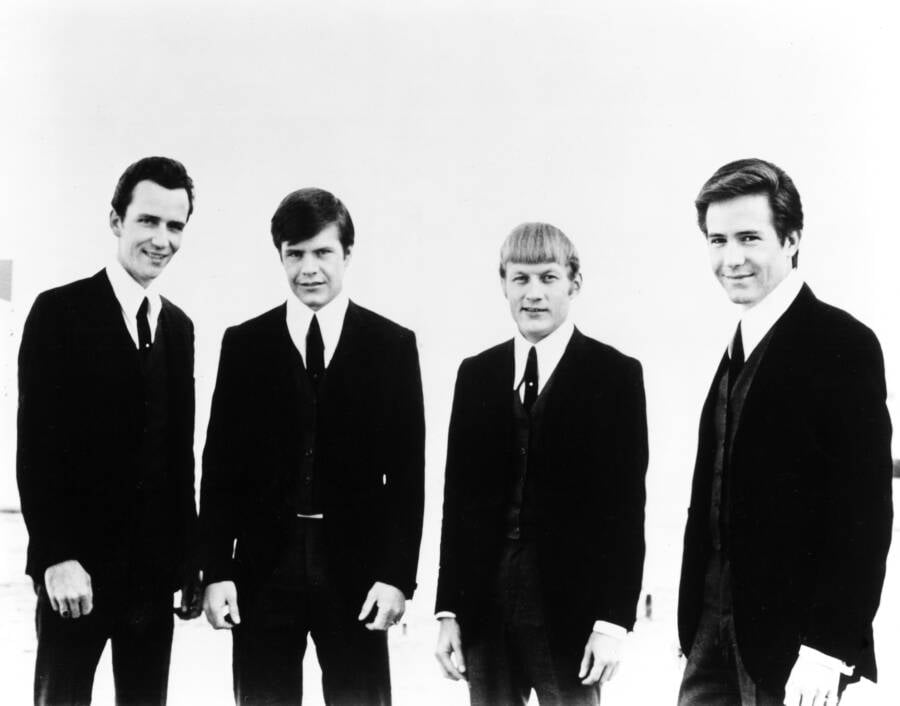
Michael Ochs Archives/Getty Images“I never really did cared for that one myself,” Fuller’s mother said of his hit “I Fought the Law.”
Theory 2: Bobby Fuller’s Death Was Murder
Whatever Fuller’s mental state might have been, the official “suicide” story has its own serious problems. So many, in fact, that the LAPD’s official records were later changed to “accidental.”
Fuller was found inside the driver’s seat of his mother’s Oldsmobile as if he’d driven himself home, but no keys were found in the ignition. And according to witnesses, Fuller’s body showed signs of violence.
In addition to the burns doctors said were caused by prolonged gasoline contact under the hot sun, he was covered in bruises and one finger was bent backward. And by the time he was discovered, Fuller’s body showed signs of rigor mortis — the post-mortem stiffening of the body — which usually does not happen until several hours after death. Further, Fuller’s bladder was full which indicated that he had perhaps been unconscious for some time before he died.
If Bobby Fuller killed himself by purposefully drowning in gasoline, did he also break his own finger and ditch the car keys? If only Bobby Fuller was involved in his death and he had been dead for hours, where was the car all the other times his mother had looked for it?
“There Was No Way That Guy Woulda Committed Suicide.”
As fellow bandmember, DeWayne Quirico put it, “I can guarantee you it was a murder. There was no way that guy woulda committed suicide, he had too much going for him. He did not wanna die. They said he died accidentally of asphyxiation with gasoline all inside the car, and he was dead when the car wasn’t there? And Mrs. Fuller just checked half an hour before and there was no car there? And half an hour later after she checks it, she finds her son in the car? Yeah, right.”
Part of the reason for these oversights might be the simultaneous shakeups taking place at the LAPD. Just two days earlier, the chief of police died and the head of the city’s homicide division was chosen to replace him. With an easy explanation in sight, there didn’t seem to be a reason to question the suicide determination. But Fuller’s father later hired a private detective, possibly inspiring the future change to “accidental.”
Randy Fuller finds the suicide story hard to believe as well. Considering that Bobby Fuller had once caught Randy huffing gas and stopped him because of the lead content, he didn’t think this explanation held much weight. An additionally troubling fact is that the LAPD officers on the scene threw out the gas can without even dusting it for fingerprints.
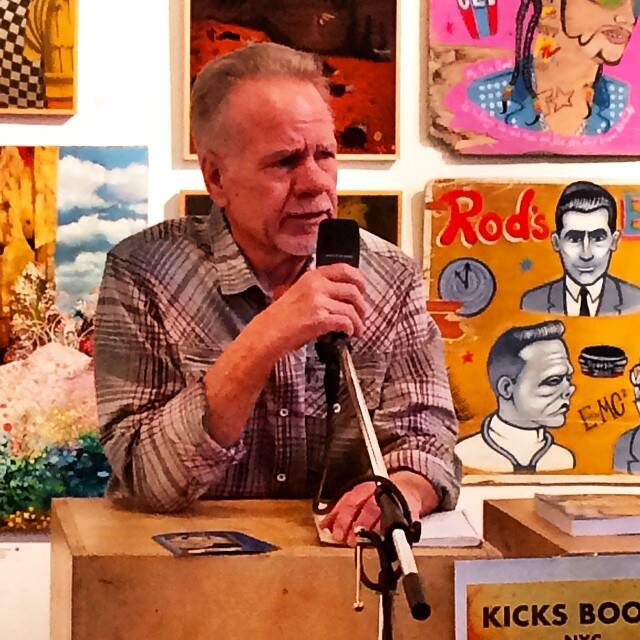
Creative CommonsRandy Fuller at a speaking engagement in 2015.
Other Theories About Bobby Fuller’s Death
The family of singer Sam Cooke, who was shot under strange circumstances in Los Angeles in 1964, has suggested that Bobby Fuller’s death could be connected. Meanwhile, other folks have speculated about whether Charles Manson killed him. However, that theory is actually impossible since Manson was imprisoned when Fuller died.
While a single definitive suspect still eludes us, the context around Bobby Fuller’s death has lead to many different theories about what might have happened. Notably, Bobby Fuller was likely preparing to break contract and go solo or perhaps even leave Los Angeles altogether, leaving both Del-Fi and their investors in the lurch.
It was an open secret at that time that some of these investors and many local music venue owners had ties to organized crime. There are even rumors that a woman Bobby Fuller went to meet the night he went missing was romantically tied to a mobster.
But as Randy Fuller points out in his book I Fought The Law: The Life and Strange Death of Bobby Fuller, if this was a mob hit, it was a very sloppy one. After all, if you covered a body in gasoline, why wouldn’t you take it somewhere remote and burn it? Why leave a body somewhere so public where someone is guaranteed to find it?
A Possible, Though Deceased, Suspect In Bobby Fuller’s Death
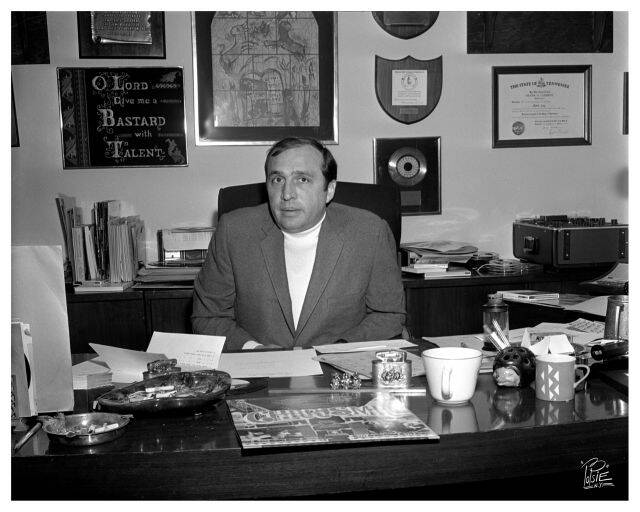
Wikimedia CommonsMorris Levy at his Roulette Records office. 1969.
While no official suspect will ever be named, I Fought the Law suggests music producer Morris Levy could have been involved in Fuller’s death. Levy, sometimes called the “Godfather of the American Music Business,” died in 1990. At the time though, he was under a federal sentence of 10 years in prison on an extortion sentence.
In addition to his reputation for having uncooperative people roughed up, Levy might have had a financial incentive to go after Fuller. Levy’s company, Roulette Records, had made an exclusive distribution deal with Del-Fi, and The Bobby Fuller Four’s last single, “The Magic Touch,” was written by a songwriter linked to Roulette. Randy thinks it’s likely that his brother’s death may be connected to a business deal he wanted out of.
Although far from conclusive, Randy Fuller remembers his brother meeting with Bob Keane and a third man, later identified as Levy, during the New York leg of their ill-fated 1966 tour.
What If Bobby Fuller Had Lived?

Public DomainBobby Fuller’s death certificate. The ruling of “suicide” was changed in October 1966 to “accidental.”
As for the abandoned European tour that could have been, to some observers, it presents a tantalizing “what if?”
To quote I Fought the Law co-author Miriam Linna, “If that had happened, I honestly believe today’s music scene would be vastly different. [Fuller] would have represented the second coming of Buddy Holly, who eight years earlier had toured Britain, inspiring everyone from the fledgling Beatles to those guys who ended up being in a band called the Rolling Stones.”
Instead, unfortunately, Fuller was fated to fulfill a different role in a second, smaller, “Day the Music Died.”
Bobby Fuller had the desire to be American music’s answer to the British Invasion. As he once said, the Beatles couldn’t play Texas rock ‘n’ roll, because “they aren’t from West Texas.” Now, more than 50 years after Bobby Fuller’s death, one can’t help but wonder what decades of popular music might have sounded like had he not left the world so soon and so inexplicably.
If you enjoyed this article on the mysterious death of Bobby Fuller and want to read another ambiguous musical end, explore the open questions surrounding the death of Jimi Hendrix. Then or another unsolved Los Angeles crime story, look no further than the unexplained death of Elisa Lam.





